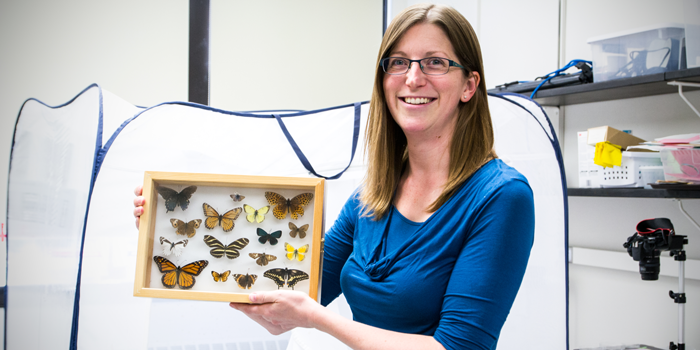
If you think it’s hard to keep track of your diet for even a single week, just imagine trying to record one hundred million years of eating patterns. Emilie Snell-Rood did just that for 96 butterfly species.
Snell-Rood wasn’t interested in calorie-counting, however. She wanted to find out if different types of nutrients played a role in shaping the evolutionary history of five closely-related families of butterflies. “It’s really hard to quantify diet,” she says, noting that prior studies have provided coarse comparisons across animals — for instance, carnivores versus herbivores. “We wanted to test the idea that nutrition shapes life history evolution at a finer level.”
Butterflies are ideal subjects for this type of study because many species have specialized to feed on only a couple of specific plant types. Furthermore, ecologists have precisely measured the nutrient content of those plants. Snell-Rood drew on this pre-existing body of knowledge to correlate the nutrition of different species’ food with a broad range of phenotypic features.
Snell-Rood began this work back in 2011 when she first joined the Department of Ecology, Evolution and Behavior. Half the butterflies in the study came from the University’s massive insect collection. The other half were collected by hand from the field. “People get very into catching butterflies," says Snell-Rood, who giddily recounts field stories of students plunging into muddy local bogs, trips to Florida mangrove forests, and breathless bolts across alpine Montana meadows in pursuit of desired specimens.
After capturing the colorful insects, Snell-Rood transported them alive back to the lab, where undergrad research assistants helped to measure the size of their eggs, testes, bodies, brains, and eyes. Next came the task of identifying how nutrition might have affected the evolution of these features.
Snell-Rood looked at three elements in the butterflies’ diets: nitrogen, sodium, and phosphorus. Nitrogen is a necessary nutrient for protein building, sodium is critical for proper functioning of muscle and nervous systems, and phosphorous is thought to be important for growth rate.
She found that butterfly species with nitrogen-rich diets tended to have larger numbers of eggs, though the eggs themselves were relatively smaller. “There’s usually a tradeoff between how many offspring you have and how much you invest in each one,” she says.
Snell-Rood also found that diets high in both nitrogen and sodium probably led to the evolution of larger eyes. In butterflies, the visual system is important for finding both food and mates, which puts big-eyed beauties at an evolutionary advantage — but why does any of this matter?
From an applied perspective, modern society is altering the balance of nutrients in the environment. For example, heavy farm fertilization and increasing atmospheric deposition are both driving up nitrogen concentration in the soil, while road salts are similarly increasing sodium content in some places. “We are changing evolutionary selection pressures on traits,” says Snell-Rood. “Pests might be evolving to be more fecund because, on average, their diet is of higher quality.”
These results might also support the theory that shifts in primate diet were an important driver in human evolution. “As we started to cook food more often, and eat more meat and fish, the quality of our diet increased,” says Snell-Rood. “This may have allowed us to allocate more energy to our brains, decrease our gut length, and increase our lifespan.”
The paper represents the culmination of years of effort on the part of Snell-Rood and her students. “This project has been a labor of love that has consumed the lab for five years,” she says. “In due time, there is so much more these butterflies will reveal.” — Colleen Smith
“We wanted to test the idea that nutrition shapes life history evolution at a finer level.”